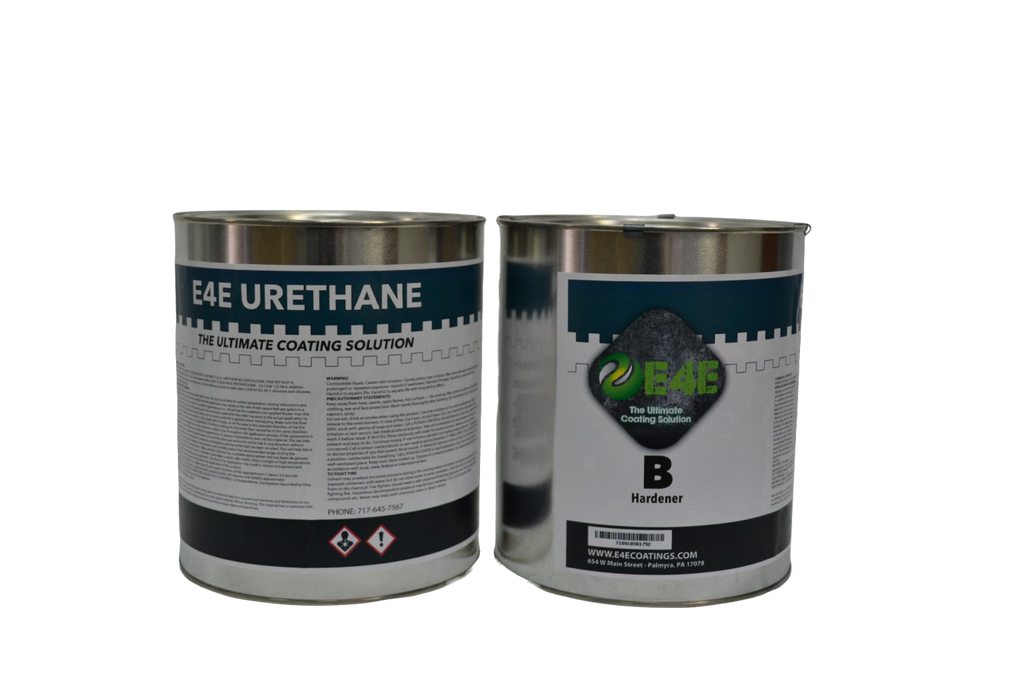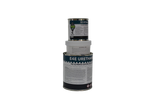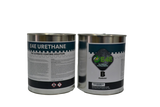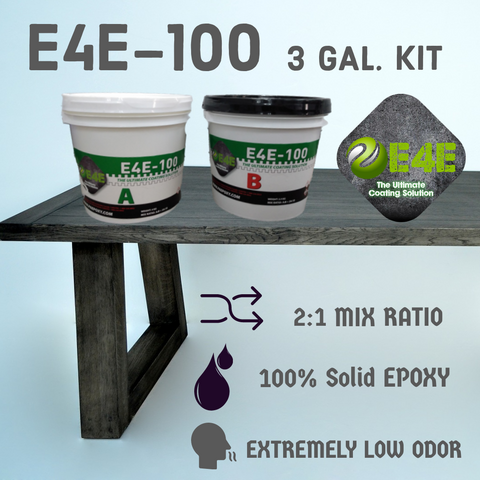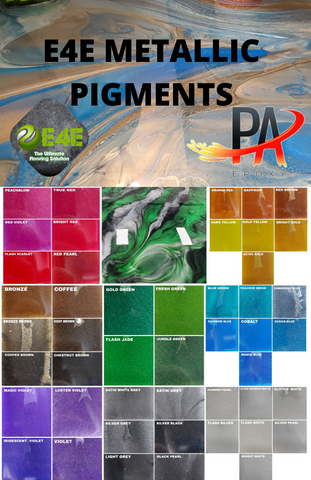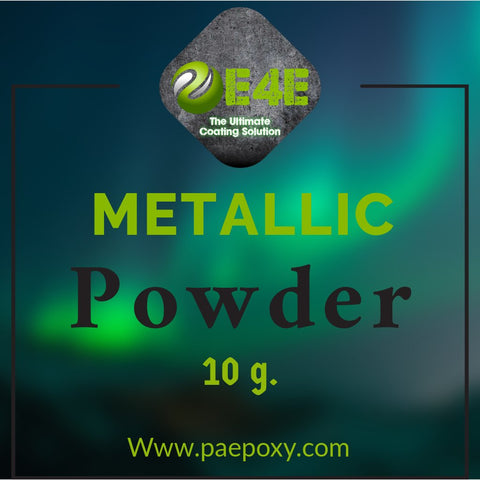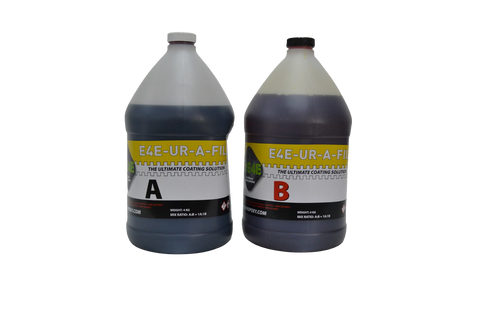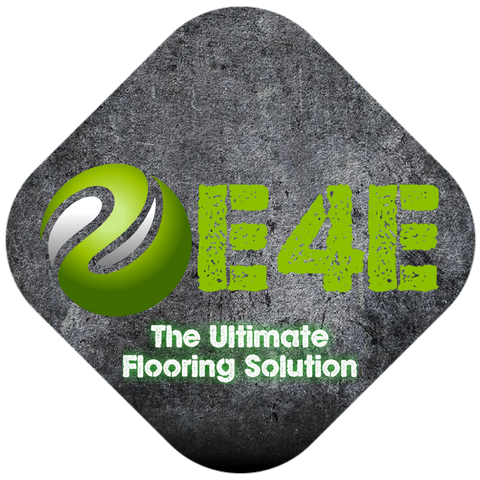PRODUCT DESCRIPTION:
HIGH PERFORMANCE URETHANE is a three component aliphatic urethane floor finish that exhibits excellent characteristics for abrasion resistance,
chemical resistance, flexibility, weathering and UV stability.
RECOMMENDED FOR:
Recommended for auto service centers, warehouses, computer rooms, laboratories, aircraft hangers, cafeterias, and some chemical exposure areas.
SOLIDS BY WEIGHT and VOLUME:
Mixed= 93% solids by weight / 92% solids by volume (+,-2%)
VOLATILE ORGANIC CONTENT:
Less than 95 grams per liter (for colors or clear mixed)
STANDARD COLORS:
Opaque clear/amber clear with color options using our urethane color
packs. The colorants may be added at the ratio of 1 pint per gallon kit
of the HIGH PERFORMANCE URETHANE product. However, the
colorants may not impart a total hide over dissimilar colored basecoats
and therefore, a basecoat must be applied in the same color before
applying this product. Color packs available for this product line are
white, off white, light gray, medium gray, charcoal gray, tile red, tan,
light blue and blue. The clear is not suitable as a topcoat over colored
systems.
COVERAGE PER GALLON Kit (colors):
600 square feet per gallon (a gallon kit + pigment = approximately 1.1
gallons and yields 660 square feet actual coverage per colored kit.
COVERAGE PER GALLON KIT (clear):
600 square feet per gallon kit
PACKAGING INFORMATION
1 gallon kits (1 pint part A) with (0.70 gallons part B) and (3.0# part C.)
(weights and volumes approximate) (approximately 1 gallon)
MIX RATIO:
1.08# part A with 6.45# part B and 3.0# part C (weights approximate)
FINISH CHARACTERISTICS:
Semi-gloss/eggshell (typical gloss is 20-40 @ 60 degrees)
SHELF LIFE: 6 months in unopened containers.
ABRASION RESISTANCE:
Taber abrasor CS-17 calibrase wheel with 1000 gram total load and
500 cycles = 15-20 mg loss
IMPACT RESISTANCE:
Gardner Impact = 160 in. lb. (passed)
FLEXIBILITY:
No cracks on a 1/8” mandrel
ADHESION:
On a properly prepared epoxy basecoat, the adhesion should exceed
300 psi @ elcometer (concrete failure, no delamination)
VISCOSITY:
Mixed liquids A/B = 1000-2000 cps (typical)
DOT CLASSIFICATIONS:
Part A “NA1993, COMBUSTIBLE LIQUID N.O.S., 3, PG III”
Part B“ ENVIRONMENTALLY HAZARDOUS SUBSTANCES,
LIQUID, N.O.S., UN3082, 9, PGIII,”
CURE SCHEDULE: (70°F)
pot life – 1 gallon volume (maximum time to apply)............. 1-2 hours
tack free (dry to touch)................................................3-6 hours
recoat or topcoat....................................................... 6-10 hours
light foot traffic.....................................................14-24 hours
full cure (heavy traffic)... ...............................................3-5 days
APPLICATION TEMPERATURE:
50-90 degrees F with relative humidity between 50-90%
CHEMICAL RESISTANCE:
REAGENT RATING
acetic acid 5% C
mek B
gasoline D
50% sodium hydroxide D
10% sulfuric D
10% hydrochloric acid D
20% nitric acid C
ethylene glycol D
Rating key: A - not recommended, B - 2 hour term splash spill, C - 8 hour term
splash spill, D - 72 hour immersion, E - long term immersion. NOTE: extensive
chemical resistance information is available through your sales representative.
TOPCOAT:
We do not recommend multiple coats of this product or other topcoats.
LIMITATIONS:
Color or gloss may be affected by humidity, temperatures, chemical
exposure, application thickness, exposure to lighting such as sodium
vapor lights. For best results use a high quality 3/8” nap roller.
Slab on grade requires moisture barrier
Substrate temperature must be 5°F above dew point
All new concrete must be cured for at least 30 days
Physical properties are typical values and not specifications
Tire contact may cause staining and discoloration
Colors may vary from batch to batch, therefore, use only product from
the same batches for an entire job.
See reverse side for application instructions.
See reverse side for limitations of our liability and warranty.
Do not use if relative humidity is below 25%
Material has to be applied at the recommended thickness per gallon
uniformly for proper appearance and development of physical
properties.
The epoxy basecoat must be abraded/de-glossed for proper adhesion.
INSTRUCTIONS(HIGH PERFORMANCE URETHANE)
1) PRODUCT STORAGE: Store product at normal room temperature before using. Storage should be between 60 and 90 degree F.
2) SURFACE PREPARATION: Surface preparation will vary according to the type of complete system to be applied. For a one or two
coat thin build system over concrete, (3-10 mils dry) we recommend either mechanical scarification or acid etching until a suitable profile
is achieved. For a complete system build higher than 10 mils dry, we recommend a fine brush blast (shot blast). All dirt, oil, dust, foreign
contaminants and laitance must be removed to assure a trouble free bond to the substrate. A test should be made to determine that the
concrete is dry; this can be done by placing a 4’ X 4’ plastic sheet on the substrate and taping down the edges. If after 24 hours, the
substrate is still dry below the plastic sheet, then the substrate is dry enough to start coating. The plastic sheet testing is also a good
method to determine if any hydrostatic pressure problems exist that may later cause disbonding. It is crucial that the epoxy basecoat is
thoroughly sanded until the surface is de-glossed and appropriately and thoroughly scratched. It is recommended that a minimum 80 grit
paper be used.
3) PRODUCT MIXING: This product has three components. The part A should be mixed with the part B thoroughly and then the part C
should be added and mixed in well to insure a uniform mixture. The kits come prepackaged and should be used in their entirety and
should not be broken down. If a color pack is used, it is recommended that the color pack be combined with the part A and part B prior to
adding the part C aggregate and then mixed well. After the three (or four, if color packs are used) parts are combined, mix extremely well
with slow speed mixing equipment such as a jiffy mixer until the material is thoroughly mixed and streak free. Avoid whipping air into
the coating. Improper mixing may result in product failure. Once the material is opened, it cannot be re-sealed for later use.
4) PRODUCT APPLICATION: Pour the mixed material into the application tray. Apply at the rate of 600 square feet per gallon in a
uniform manner with a 3/8” nap roller. For uniform appearance, it is critical that the material is not applied thicker than this application
rate. Dip the roller in the coating and roll out excess material in the roller tray prior to the actual application to the substrate. Overlap
subsequent passes being sure no excess material is applied when overlapping. Make sure the floor has just enough material to cover
evenly in a thin application. Finally, re-roll the area in the opposite direction of the first pass applications to level and even the
application. The final re-rolling for the entire floor should be in the same direction. Remix the material in the application tray to maintain
a uniform mix throughout the application process. If the appearance is not satisfactory, re-roll until the area is uniform in appearance. It is
almost impossible to over-roll this material. The last step in the application process (wearing spiked shoes) is to pull the roller tool across
the entire slab in one direction without applying any pressure and repeating this process by overlapping until the entire slab has been re-
rolled. This will help blend in any roller and overlap marks. Maintain temperatures and humidity within the recommended ranges during
the application and during the curing process. Make sure the substrate has a suitable epoxy primer that has been de-glossed (see surface
preparation above) It is best to maintain a wet edge to avoid roller marks. Direct sunlight or high temperatures may cause visible roller
marking during application. Too thick of an application may result in solvent entrapment and product failure. The Surface must be dry
before the application of this product.
5) RECOAT OR TOPCOATING: Multiple coats of this product are not recommended without thoroughly evaluating the adhesion in
conjunction with a thorough deglossing. If you opt to apply multiple coats of this product, a test area must be applied to test adhesion
before attempting to apply multiple coats over the entire job. If you opt to recoat this product, you must first be sure that all of the solvents
have evaporated from the coating during the curing process and properly de-gloss and roughen the surface (see surface preparation
above). The information on the front side are reliable guidelines to follow. However, it is best to test the coating before recoating or
topcoating. This can be done by pressing on the coating with your thumb to verify that no fingerprint impression is left. Always
remember that colder temperatures will require more cure time for the product. Before recoating or topcoating, check the coating to insure
no contaminants exist. If contaminants are present on a previous coat, remove with a standard detergent cleaner and allow to thoroughly
dry. Although not recommended, when recoating this product with subsequent coats, it is advisable to apply the recoat before 24-48 hours
pass only after proper surface preparation and adhesion testing has been completed.
6) CLEANUP: Use ketone solvents or other suitable cleaning solvent
7) FLOOR CLEANING: Caution! Some cleaners may affect the color of the floor installed. Test each cleaner in a small area, utilizing
your cleaning technique. If no ill effects are noted, you can continue to clean with the product and process tested.
8) RESTRICTIONS: Restrict the use of the floor to light traffic, non-harsh chemicals and water until the coating is fully cured..
Dependent on actual complete system application, surface may be slippery, especially when wet or contaminated; keep surface clean
and dry.
HIGH PERFORMANCE URETHANE is a three component aliphatic urethane floor finish that exhibits excellent characteristics for abrasion resistance,
chemical resistance, flexibility, weathering and UV stability.
RECOMMENDED FOR:
Recommended for auto service centers, warehouses, computer rooms, laboratories, aircraft hangers, cafeterias, and some chemical exposure areas.
SOLIDS BY WEIGHT and VOLUME:
Mixed= 93% solids by weight / 92% solids by volume (+,-2%)
VOLATILE ORGANIC CONTENT:
Less than 95 grams per liter (for colors or clear mixed)
STANDARD COLORS:
Opaque clear/amber clear with color options using our urethane color
packs. The colorants may be added at the ratio of 1 pint per gallon kit
of the HIGH PERFORMANCE URETHANE product. However, the
colorants may not impart a total hide over dissimilar colored basecoats
and therefore, a basecoat must be applied in the same color before
applying this product. Color packs available for this product line are
white, off white, light gray, medium gray, charcoal gray, tile red, tan,
light blue and blue. The clear is not suitable as a topcoat over colored
systems.
COVERAGE PER GALLON Kit (colors):
600 square feet per gallon (a gallon kit + pigment = approximately 1.1
gallons and yields 660 square feet actual coverage per colored kit.
COVERAGE PER GALLON KIT (clear):
600 square feet per gallon kit
PACKAGING INFORMATION
1 gallon kits (1 pint part A) with (0.70 gallons part B) and (3.0# part C.)
(weights and volumes approximate) (approximately 1 gallon)
MIX RATIO:
1.08# part A with 6.45# part B and 3.0# part C (weights approximate)
FINISH CHARACTERISTICS:
Semi-gloss/eggshell (typical gloss is 20-40 @ 60 degrees)
SHELF LIFE: 6 months in unopened containers.
ABRASION RESISTANCE:
Taber abrasor CS-17 calibrase wheel with 1000 gram total load and
500 cycles = 15-20 mg loss
IMPACT RESISTANCE:
Gardner Impact = 160 in. lb. (passed)
FLEXIBILITY:
No cracks on a 1/8” mandrel
ADHESION:
On a properly prepared epoxy basecoat, the adhesion should exceed
300 psi @ elcometer (concrete failure, no delamination)
VISCOSITY:
Mixed liquids A/B = 1000-2000 cps (typical)
DOT CLASSIFICATIONS:
Part A “NA1993, COMBUSTIBLE LIQUID N.O.S., 3, PG III”
Part B“ ENVIRONMENTALLY HAZARDOUS SUBSTANCES,
LIQUID, N.O.S., UN3082, 9, PGIII,”
CURE SCHEDULE: (70°F)
pot life – 1 gallon volume (maximum time to apply)............. 1-2 hours
tack free (dry to touch)................................................3-6 hours
recoat or topcoat....................................................... 6-10 hours
light foot traffic.....................................................14-24 hours
full cure (heavy traffic)... ...............................................3-5 days
APPLICATION TEMPERATURE:
50-90 degrees F with relative humidity between 50-90%
CHEMICAL RESISTANCE:
REAGENT RATING
acetic acid 5% C
mek B
gasoline D
50% sodium hydroxide D
10% sulfuric D
10% hydrochloric acid D
20% nitric acid C
ethylene glycol D
Rating key: A - not recommended, B - 2 hour term splash spill, C - 8 hour term
splash spill, D - 72 hour immersion, E - long term immersion. NOTE: extensive
chemical resistance information is available through your sales representative.
TOPCOAT:
We do not recommend multiple coats of this product or other topcoats.
LIMITATIONS:
Color or gloss may be affected by humidity, temperatures, chemical
exposure, application thickness, exposure to lighting such as sodium
vapor lights. For best results use a high quality 3/8” nap roller.
Slab on grade requires moisture barrier
Substrate temperature must be 5°F above dew point
All new concrete must be cured for at least 30 days
Physical properties are typical values and not specifications
Tire contact may cause staining and discoloration
Colors may vary from batch to batch, therefore, use only product from
the same batches for an entire job.
See reverse side for application instructions.
See reverse side for limitations of our liability and warranty.
Do not use if relative humidity is below 25%
Material has to be applied at the recommended thickness per gallon
uniformly for proper appearance and development of physical
properties.
The epoxy basecoat must be abraded/de-glossed for proper adhesion.
INSTRUCTIONS(HIGH PERFORMANCE URETHANE)
1) PRODUCT STORAGE: Store product at normal room temperature before using. Storage should be between 60 and 90 degree F.
2) SURFACE PREPARATION: Surface preparation will vary according to the type of complete system to be applied. For a one or two
coat thin build system over concrete, (3-10 mils dry) we recommend either mechanical scarification or acid etching until a suitable profile
is achieved. For a complete system build higher than 10 mils dry, we recommend a fine brush blast (shot blast). All dirt, oil, dust, foreign
contaminants and laitance must be removed to assure a trouble free bond to the substrate. A test should be made to determine that the
concrete is dry; this can be done by placing a 4’ X 4’ plastic sheet on the substrate and taping down the edges. If after 24 hours, the
substrate is still dry below the plastic sheet, then the substrate is dry enough to start coating. The plastic sheet testing is also a good
method to determine if any hydrostatic pressure problems exist that may later cause disbonding. It is crucial that the epoxy basecoat is
thoroughly sanded until the surface is de-glossed and appropriately and thoroughly scratched. It is recommended that a minimum 80 grit
paper be used.
3) PRODUCT MIXING: This product has three components. The part A should be mixed with the part B thoroughly and then the part C
should be added and mixed in well to insure a uniform mixture. The kits come prepackaged and should be used in their entirety and
should not be broken down. If a color pack is used, it is recommended that the color pack be combined with the part A and part B prior to
adding the part C aggregate and then mixed well. After the three (or four, if color packs are used) parts are combined, mix extremely well
with slow speed mixing equipment such as a jiffy mixer until the material is thoroughly mixed and streak free. Avoid whipping air into
the coating. Improper mixing may result in product failure. Once the material is opened, it cannot be re-sealed for later use.
4) PRODUCT APPLICATION: Pour the mixed material into the application tray. Apply at the rate of 600 square feet per gallon in a
uniform manner with a 3/8” nap roller. For uniform appearance, it is critical that the material is not applied thicker than this application
rate. Dip the roller in the coating and roll out excess material in the roller tray prior to the actual application to the substrate. Overlap
subsequent passes being sure no excess material is applied when overlapping. Make sure the floor has just enough material to cover
evenly in a thin application. Finally, re-roll the area in the opposite direction of the first pass applications to level and even the
application. The final re-rolling for the entire floor should be in the same direction. Remix the material in the application tray to maintain
a uniform mix throughout the application process. If the appearance is not satisfactory, re-roll until the area is uniform in appearance. It is
almost impossible to over-roll this material. The last step in the application process (wearing spiked shoes) is to pull the roller tool across
the entire slab in one direction without applying any pressure and repeating this process by overlapping until the entire slab has been re-
rolled. This will help blend in any roller and overlap marks. Maintain temperatures and humidity within the recommended ranges during
the application and during the curing process. Make sure the substrate has a suitable epoxy primer that has been de-glossed (see surface
preparation above) It is best to maintain a wet edge to avoid roller marks. Direct sunlight or high temperatures may cause visible roller
marking during application. Too thick of an application may result in solvent entrapment and product failure. The Surface must be dry
before the application of this product.
5) RECOAT OR TOPCOATING: Multiple coats of this product are not recommended without thoroughly evaluating the adhesion in
conjunction with a thorough deglossing. If you opt to apply multiple coats of this product, a test area must be applied to test adhesion
before attempting to apply multiple coats over the entire job. If you opt to recoat this product, you must first be sure that all of the solvents
have evaporated from the coating during the curing process and properly de-gloss and roughen the surface (see surface preparation
above). The information on the front side are reliable guidelines to follow. However, it is best to test the coating before recoating or
topcoating. This can be done by pressing on the coating with your thumb to verify that no fingerprint impression is left. Always
remember that colder temperatures will require more cure time for the product. Before recoating or topcoating, check the coating to insure
no contaminants exist. If contaminants are present on a previous coat, remove with a standard detergent cleaner and allow to thoroughly
dry. Although not recommended, when recoating this product with subsequent coats, it is advisable to apply the recoat before 24-48 hours
pass only after proper surface preparation and adhesion testing has been completed.
6) CLEANUP: Use ketone solvents or other suitable cleaning solvent
7) FLOOR CLEANING: Caution! Some cleaners may affect the color of the floor installed. Test each cleaner in a small area, utilizing
your cleaning technique. If no ill effects are noted, you can continue to clean with the product and process tested.
8) RESTRICTIONS: Restrict the use of the floor to light traffic, non-harsh chemicals and water until the coating is fully cured..
Dependent on actual complete system application, surface may be slippery, especially when wet or contaminated; keep surface clean
and dry.
Translation missing: en.general.search.loading


